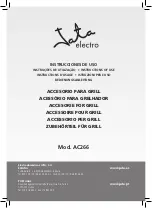
25
ENGLISH
QUICK START GUIDE
SIMOGAS GRIDDLE
You just bought a Simogas Griddle and this is why we want first of all, to thank you for the trust you have placed in us, cer-
tainly we will not disappoint you. We will give you a few tips to get the most out of your new Spanish Griddle Simogas.
1.
Open the carton and check that it contains: The griddle with its data plate, lighter or piezoelectric, instruction manual,
4 feet for the griddle, 1 or 2 injectors for natural gas (according to the number of burners). Now
remove the white
plastic that protects the stainless steel parts.
2. Install the griddle on a flat, fireproof surface or on the corresponding Simogas Trolley.
Use the adjustable feet to
level the griddle. In case of using the Simogas wooden trolley, place the griddle on a flat, level surface. If necessary,
introduce some washers between the trolley and the griddle, so that this is level.
3. Connect the gas pipe
(not supplied) to the gas inlet located on one side o the griddle. Make sure that there is no gas
leak. Refer to specific regulations for your city or country, since it is possible that the connection should be made by a
qualified installer.
4. How to turn the griddle on.
The griddle is equipped with safety Thermocouple that ensures no gas leaks, as it closes
the gas valve if the burner is not turned on or is turned off. To turn on the griddle, press the valve black button and
turn it to the left at maximum power. Holding down the button, press the piezoelectric ignitor to cause a spark and
the burner ignition (for models with piezoelectric). If the model does not have a piezoelectric ignition, turn on the
lighter and keep it close to the burner. Once the burner is lit, hold the throttle for a few seconds and then release. If
the burner goes out, repeat the operation holding the knob down for a few seconds.
5. Let the griddle heat
for 5 to 10 minutes at full power. This is the required time to reach 300 º C temperature,
necessary for proper cooking on the grill. This temperature allows food (especially meat) cicatrize quickly in contact
with the griddle, and thus retain all its juices and flavours.
6. Cleaning the rolled carbon steel plate.
While he griddle is still hot, pour some ice cubes over the plate. This will help
remove food debris stuck to it. Remove with a spatula the loose food debris. When you have finished cleaning the
plate spread a thin layer of oil onto the surface to protect from oxidation. Namely the provisory food coating begins
to disappear from first use. Avoid using lemon, vinegar or other acid (food or non food), because it accelerates the
disappearance of the coating.
7. Cleaning the enamelled cast steel plate.
Avoid great temperature contrasts. do not use ice cubes. Use water at room
temperature, which will help you clean the food debris by means of a spatula. Finish cleaning with a mild detergent.
No need to grease the enamel plate, as it will not show sign of rust. avoid using lemon, vinegar or other acid (food or
non food) because it attacks on enamel surfaces.
8.
If you are not going to use the griddle for an extended period of time, store it indoors. Spread a thin layer of oil onto
the steel surface (no enamel). Cover it, preventing the griddle is in contact with anything, to avoid rusting.
9.
If the griddle (no enamel) shows signs of rust, scrape the rust with a pumice stone or use fine-grit sandpaper, or with
a rust remover for food use. Clean and rinse the plate before use to prevent any remaining traces of detergents, rust,
pumice, or other components.
This equipment must be installed in compliance with current regulations and must only be used in places with sufficient ven-
tilation. Consult instructions before installation and use of this equipment.
This installation, use and maintenance manual must be read before performing any operation with the equipment.
It is recommended that this manual be kept in a location that is visible and accessible to the user for future consultations.
It is recommended that the condition of the equipment be checked before its installation and verified that it has not suffered
any damage during transport.
The manufacturer is not responsible if the equipment is installed without following the installation instructions.
The manufacturer is not responsible for operation of the equipment if the user does not follow the suggestions for use of the
instruction manual.
The manufacturer is not responsible for malfunctions due to incorrect use of the equipment.
Parts that have been protected by the manufacturer and its agent MUST NOT be handled by the installer and user.
The manufacturer is not responsible for any manipulation of the equipment by the user.
Installation and maintenance operations shall be performed by qualified technical personnel.
EN
















































